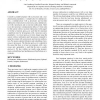Free Online Productivity Tools
i2Speak
i2Symbol
i2OCR
iTex2Img
iWeb2Print
iWeb2Shot
i2Type
iPdf2Split
iPdf2Merge
i2Bopomofo
i2Arabic
i2Style
i2Image
i2PDF
iLatex2Rtf
Sci2ools
APPINF
2003
2003
Comparing the Optimal Performance of Multiprocessor Architectures
Consider a parallel program with n processes and a synchronization granularity z. Consider also two multiprocessors: a multiprocessor with q processors and run-time reallocation of processes to processors, and a multiprocessor with k processors and no run-time reallocation. There is an inter processor communication delay of t time units for the system with no run-time reallocation. In this paper we define a function g(n,k,q,t,z) such that the minimum completion time for all programs with n processes and a granularity z is at most g(n,k,q,t,z) times longer using the system with no reallocation and k processors compared to using the system with q processors and run-time reallocation. We assume optimal allocation and scheduling of processes to processors. The function g(n,k,q,t,z) is optimal in the sense that there is at least one program, with n processes and a granularity z, such that the ratio is exactly g(n,k,q,t,z). We also validate our results using measurements on distributed and ...
| Added | 31 Oct 2010 |
| Updated | 31 Oct 2010 |
| Type | Conference |
| Year | 2003 |
| Where | APPINF |
| Authors | Lars Lundberg, Kamilla Klonowska, Magnus Broberg, Håkan Lennerstad |
Comments (0)

